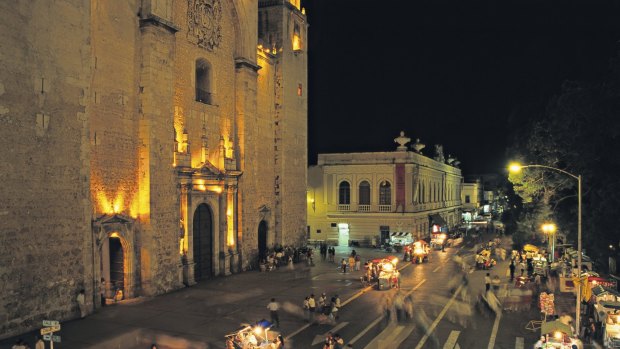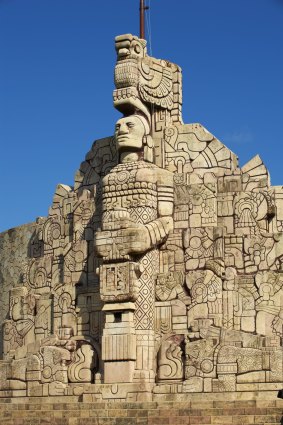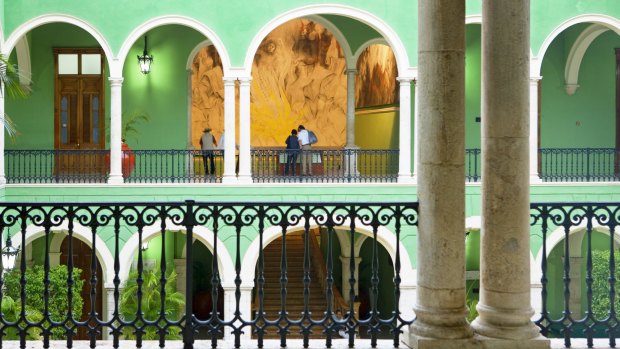This was published 9 years ago
Yucatan Peninsula, Mexico: Vibrant culture and rich history
The Yucatan Peninsula boasts ancient ruins and a rich history but why do so few travellers know about it, writes Steve McKenna

Merida at night. Credit: iStock
Beneath the cloistered, salmon-shaded arcades that frame Merida's pretty Plaza Grande, a trio of troubadours pluck their guitar strings and sing sweet, heartfelt tunes to an amorous teenage couple slurping mango sorbets.
Mayan women shuffle past, with technicolour bags and blankets draped across their shoulders, a young Meridano family embarks from a calesa (a horse-drawn taxi), and chubby, middle-aged, mustachioed salesmen, armed with bundles of Cuban cigars ("Good price! Good price!"), chew the fat with vendors rustling up marquesitas – the Yucatecan answer to a crepe.
As the smell of melting chocolate and cheese pervades the still-balmy tropical night air, an all-male brass band appears, accompanied by a dozen female dancers dressed in white, flower-patterned gowns and head-scarves. Their spirited folksy performance casts an enchanting spell over the square and its bulging swarm of onlookers, myself included.

Monumento a la Patria,Credit: Getty Images
While some Latin American centres are no-go areas after dark, Merida's is the place to be.
The unheralded capital of the Yucatan Peninsula, Merida is safe, charming and family-friendly, but also vibrant, cultural and festive. It's a far cry from the violent, drug-and-gang-infested border towns that have given Mexico its dangerous reputation. Yet despite emerging as a favourite relocation spot for American and European expats, it remains relatively off the beaten tourist track, largely ignored by the masses more inclined to trample the ruins of ancient, long-lost cities in the Yucatán's jungly interior, or party and sunbathe at the resorts on the Caribbean coast.
Merida couldn't be any different from my previous Yucatan pitstop. While Cancun, a four-hour bus ride away, was purpose-built for tourism in the 1960s, some historians believe Merida is the oldest continually settled city in the Americas.
The Yucatan cuisine sports Mexican, Mayan, European and Caribbean influences.
The Spanish Conquistadors arrived in the early 16th century and were stunned by the thriving Mayan settlement of Tiho. With its limestone temples and pyramids, it drew comparisons with the old Roman city of Merida in mainland Spain.
After quashing local resistance, the Spanish had the structures dismantled, with the enslaved Mayans forced to recycle the stones into stately buildings of the Spaniards' choosing, including the imposing cream-shaded, twin-towered cathedral, among the earliest built in the New World, and the smaller, and easier-on-the-eye, Jesuit Church of the Third Order of Jesus.
Situated just a block away from the plaza, alongside lofty palms, its ornate interior is adorned with stained-glass windows, chandeliers and religious paintings, while Mayan carvings decorate the sides.

A pastel building in Merida.Credit: Getty Images
The Conquistadors' brutality and the Mayans' resistance to their occupation is documented in a series of powerful, striking murals by Fernando Castro Pacheco, one of the Yucatan's most revered painters (born in Merida in 1918, died in 2013).
The 27 murals are displayed over two storeys of the old mint-green governor's palace, one of several must-visit (and free) daylight attractions around Plaza Grande.
Others include the MACAY, the contemporary art museum (which stocks some impressive, and head-scratching, modern Latin American art), in the old bishop's palace, and Casa de Montejo, a lavishly restored mansion. Once the former home of Conquistador Francisco de Montejo, it's the epitome of colonial swank, decked out with elegant furniture and period pieces from Asia, Africa and Europe and flaunting gleaming black and white chequered flooring.
Merida is known as the Ciudad Blanca (White City), but most of its low-level, originally white limestone buildings, are now pastel-coloured. Wandering its grid of streets, you'll see stark contrasts between the well-kept and refurbished properties – all spotless facades, shining wrought ironwork and elaborate stucco, many hosting theatres, boutique hotels, backpacker hostels, restaurants, cafes and live music bars – and ones crumbling to pieces, either derelict and abandoned, or hiding family-run launderettes, bakeries, hardware stores and down-to-earth boozers. Plasterers, painters and decorators – and indeed fans of restoration projects – would have a field day here.
Considering its size (population approaching a million), spread-out Merida exudes a sleepy, country town vibe. The tropical heat – eased by a nightly breeze from the nearby Gulf of Mexico – and the locals' weaving skills means hammock-swaying is a favourite past-time, especially post-lunch. Filling and flavoursome, and a diversion from the standard tacos and tortas, the Yucatan cuisine sports Mexican, Mayan, European and Caribbean influences, with a signature dish being cochinita pibil (pork marinated in a sauce made of garlic, chiles, black pepper, cumin, cinnamon, oregano and vinegar, then wrapped in plantain leaves and grilled).
Colourful hammocks pepper shaded hotel courtyards and swimming pool areas, while you can buy your own, high quality, hand-woven one, for around MEX300 ($22) – though you're advised to avoid the loquacious touts on the streets ("Where you from? How long you here for? Wanna come to my shop?") and head straight for a specialist dealer, like Tejidos y Cordeles Nacionales or El Aguacate.
Other popular Yucatan souvenirs include the trinkets and wares of Mayan artisans, cotton Cuban-style guayabera shirts and jipis (the Mexican version of the Panama hat). Buy these in the dozens of shops or bustling markets around town or at the Casa de Artesanias, a government-sponsored organisation in the Casa de la Cultura, a renovated monastery.
Some goods are made of henequen, which derives from a native plant yielding strong natural fibres. Long used by the Maya, it became known as the "green gold" during the late 19th century, when plantation owners began producing it on a mass scale, feeding the huge worldwide demand for rope, yarn, sacks and ship sails.
The henequen trade declined by the 1950s – nylon superseded it – but the enormous wealth it generated is still evident, not only through the grand haciendas on Merida's outskirts, but on Paseo de Montejo, a Champs Elysee-like boulevard on the city centre's northern tip. Strolling along its wide, tree-lined pavements, I enviously admire its ostentatious properties, with their balustraded balconies, stucco flourishes and manicured lawns.
Built by the plantation owners around the turn of the 20th century, some are still lived in, while others house banking offices and upmarket hotels. The most captivating building of all – the custard-coloured Palacio Canton – doubles up as the region's anthropology museum, shining light on the Yucatan Maya's history and customs. The Maya almost retook control of Merida during the mid 19th century War of the Castes, a conflict between Merida's ruling classes and the indigenous people. Military reinforcements sent from Mexico City helped crush the rebellion.
Capping the two kilometre-long avenue (just past a Wal-Mart) is the Monumento a la Patria, a giant, show-stopping sculpture unveiled in 1956 and strewn with neo-Mayan-style engravings relating to key moments of Mexican history.
From Merida, there's a feast of day trips to nearby ruins, sinkholes, beaches and nature reserves (see side panel). I spend my last day in the city moving between my hammock and laurel-shaded Plaza Grande, where, day or night, midweek or weekend, there's always something going on – especially during the city's many festivals (barely a week goes by without some kind of celebration).
Usually the (free) entertainment is fairly cultural, drawing on the region's traditions, including trova music (Thursday nights are the best for hearing these romantic, poetic, folksy serenade-friendly melodies). However, light, silly humour also gets an airing.
It's 10pm on Sunday and a clown – wearing a red plastic nose and ridiculous yellow boots – has persuaded half-a-dozen parents to dance raunchily to a soundtrack of reggaeton, marimba and salsa.
As one grinning mother rubs her backside up and down her partner's legs and thighs, then a lamp-post, bashful and mischievous looks appear on the faces of the watching kids, while infectious laughter comes from the adults who've managed to elude the naughty clown's clutches.
THREE TRIPS FROM MERIDA
CENOTES
These water-filled limestone sinkholes, revered by the ancient Mayans, are dotted around the Yucatan Peninsula. The greatest collection is around Merida, with Xlacah, 40 metres deep, popular with swimmers and divers.
CELESTUN
This quaint fishing village, lined with beaches and seafood restaurants, is the gateway to the 591 square kilometre Celestun biosphere reserve, home to one of the world's largest pink flamingo colonies. Visitors can take a boat trip around the lagoon and snap away.
MAYAN RUINS
Chichen Itza is the most famous and best restored of the Yucatan's Mayan ruins (and an easy day trip from Merida), but for fewer crowds, consider Uxmal. Nestled in the hilly Pucc region south of Merida, it flourished between AD600-900.
Nomadas Travel (nomadastravel.com) arranges tours to all of the above
TRIP NOTES
MORE INFORMATION
GETTING THERE
ADO (ado.com.mx) buses leave from Cancun to Merida almost every half-hour. From Sydney, Delta Airlines flies to Cancun via LA and Atlanta. Flight Centre (flightcentre.com.au) has a return fare for $2841.
STAYING THERE
Nomadas Hostel has plenty of hammocks and budget-friendly rooms in a restored city centre colonial property dating back to the 1790s. Doubles, with breakfast, from MX338 ($24); nomadastravel.com
A luxury boutique hotel and spa on Paseo de Montejo, Rosas and Xocolate has doubles from US$215 ($207), room only; rosasandxocolate.com
SHOPPING THERE
Tejidos y Cordeles Nacionales warehouse, 516B, Calle 56, Merida; +1 999 928 5561
El Aguacate, 604, Calle 58, Merida; hamacaselaguacate.com.mx, +1 999 928 6429
Casa de Artesanias, 513, Calle 63; open Mon-Sat 10am-9pm, Sun 10am-2pm.
SEE + DO
Macay museum, Plaza Grande, open daily, except Tuesday, 10am-6pm; macay.org
Casa de Montejo, Plaza Grande, open Tuesday-Saturday 10am-7pm, Sundays 10am-4pm; museocasamontejo.com
Palacio de Gobierno; Plaza Grande, open daily 8am-10pm.
TIP
An incredible number of VW Beetles cough and splutter through Merida. Most are of the vintage kind and make for wonderful photographs, especially with the colonial street-scapes for a backdrop.
Sign up for the Traveller Deals newsletter
Get exclusive travel deals delivered straight to your inbox. Sign up now.